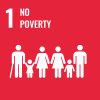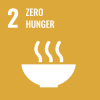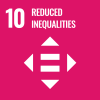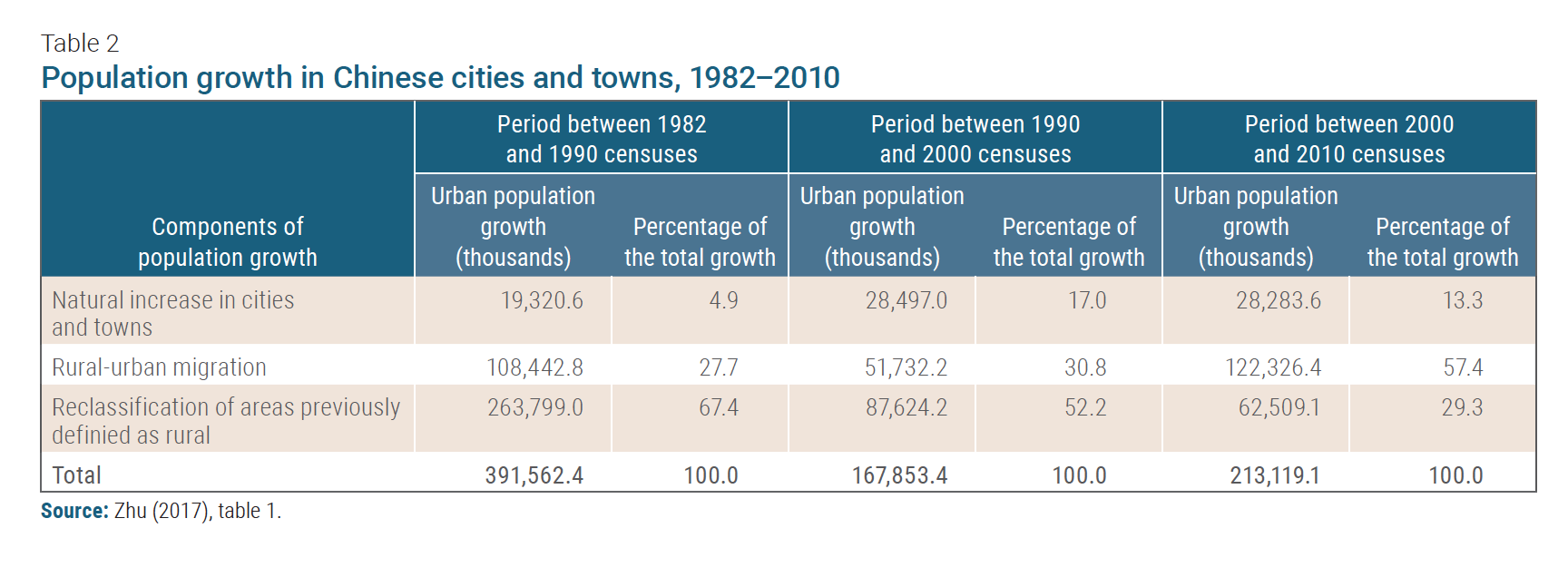
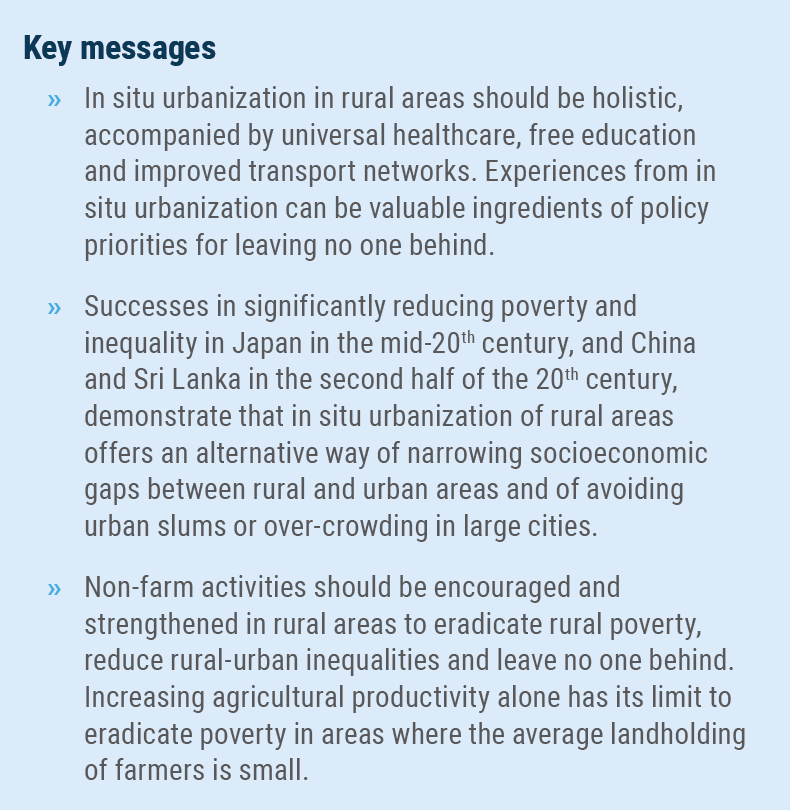 Introduction
Introduction
Four out of every five people in poverty live in rural areas. The gaps between rural and urban poverty still exist and many rural areas continue to face risks of social, economic and political marginalization. Thus, there is a concern that the population in rural communities are being left behind. This Policy Brief will argue that expanding opportunities in non-farm activities in rural areas is a key for sustainable development without “leaving no one behind”. A type of rural development called in situ urbanization of rural areas is characterized not only by expanding non-farm opportunities in the areas, but also by strengthening economic linkages with the neighbouring areas. It is further accompanied by improved access to healthcare services, education and efficient transport networks. It differs from the two well-known types of urbanization, namely “classical”, where the expansion of population is observed in pre-existing cities and “greenfield”, where previously rural areas are converted into urban areas through a sharp increase in their population size and density by the national or local authorities. Traditional rural development is centred on more intensive use of natural resources, such as land and forests, in spatial isolation. By contrast, in situ urbanization is actually a model of rural development in which the essential rural characteristic persists while the standard of living rises to that of the urban level. In situ urbanization in this sense is a structural transformation of rural communities and constitutes an important part of nation- wide transformative changes necessary for achieving the SDGs. The Brief further argues that, where the typical farmers are small landowners, technology alone may not be able to help farmers escape from poverty, and technical advances need to be complemented by a holistic approach, with the creation of jobs outside agriculture, the provision of universal health and quality education, and affordable and efficient transport networks. Simply put, rural areas need to have more urban socioeconomic characteristics if the areas have to provide their dwellers with sufficient incomes.
Rural development for leaving no one behind
Leaving no one behind requires solving the challenges faced by rural communities. Urbanization is a process of re-location of people and economic activity within or across areas. In the classical urbanization, urban areas or cities—geographical boundaries with greater concentration of people and socioeconomic activities—were born during the process of industrialization and centralization of a country; in many cases, local governments emerged, and socioeconomic infrastructure was built and improved, including road, healthcare and educational institutions. People with limited income earning opportunities in the rural areas were attracted to the cities with the hope of higher-paying jobs. In the urbanization process, rural areas are often viewed as underdeveloped, host to the poorer segments of the population and the source of unskilled migrant workers. But rural communities do not need to remain poor, underdeveloped areas. In the case of Japan that we will examine below, non-farm activities played a key role to lift farmers beyond the poverty level and beyond the average income of non-farm households in the mid-20th century. Similarly, in Indonesia in the late 1980s, the importance of local non-farm activities was recognized in rural-to-urban transformations in the areas adjacent to large cities. Such adjacent areas are called desakota, coming from Indonesian desa (village) and kota (city). Desakota points to a blurred boundary between rural and urban areas, in which farm and non-farm activities co-exist with a predominantly rural landscape. More recently, the place-based urbanization has been of growing importance in other parts of developing countries. The place-based urbanization of rural areas is often called in situ urbanization. Much less attention has been paid to a place-based transition from a rural into an urban area, though (Brown, 2018). The advancement of in situ urbanization lies in not only promoting rural development, reducing the cross-regional flow of labour migration and advancing the social and economic development; but also realizing the transformation of economic and social structure and the more geographically balanced settlement of people within a nation. It helps the city planner maintain the sustainability of the urbanization of development in the short run, and reduces population expansion pressure over the long run because of the lower rural-to-urban migration (Asada, 2020; and Guo, Shiqin and Jie Zou, 2015). In situ urbanization in a rural area is transforming the area to include more urban features, infrastructure and services, and is part of the structural transformation of the national economy. Rural areas with more urban characteristics can help eradicate rural poverty and narrow the gaps in living standards between rural and urban areas. More urbanized rural areas can also help reduce rural-to-urban migration, avoiding over-crowding or the emergence of slums in large cities. Needless to say, not all urbanization experiences have been positive as seen in crowded living conditions without decent work, the emergence of slums and the lack of basic infrastructure. One such example is “urbanization without growth” in sub-Saharan Africa (Fay and Opal, 2000; Glaeser, 2009; Jedwab and Vollrath, 2015). The absence of local governments in the increasing population-density areas have been an obstacle for the emergence of modern institutions and formal urban development. Likewise, the so-called “settlement transition” in South Asia has transformed the previous rural areas into areas with higher population density, but socioeconomic transformation has not caught up with increased populations, where increased demand for decent jobs and public services are often unmet. The path for eradicating rural poverty and rural-urban divides that each country should choose is not apparent. The causes for rural poverty and rural-urban inequalities, and the interlinkages among them, are complex and multidirectional. Therefore, it is not surprising that there are nearly as many experiences of rural development, or lack of thereof, as there are countries. The three country experiences examined below are just a small subset of a wide spectrum of rural development episodes, but they represent in situ urbanization, in which rural dwellers have seen their socioeconomic status raised to the level of urban dwellers’.
Non-farm activities for eradicating poverty and reducing rural-urban gaps: early success in Japan
Rural areas in Japan before the end of World War II faced high population growth, structural underemployment, stagnating agricultural productivity, and the lack of financial resources—common characteristics in rural areas in many parts of advanced present-day developing countries, in which farmers are often small landowners. With the introduction of systematic rural and social development planning, rural areas in Japan overcame these obstacles, with increased agricultural productivity. 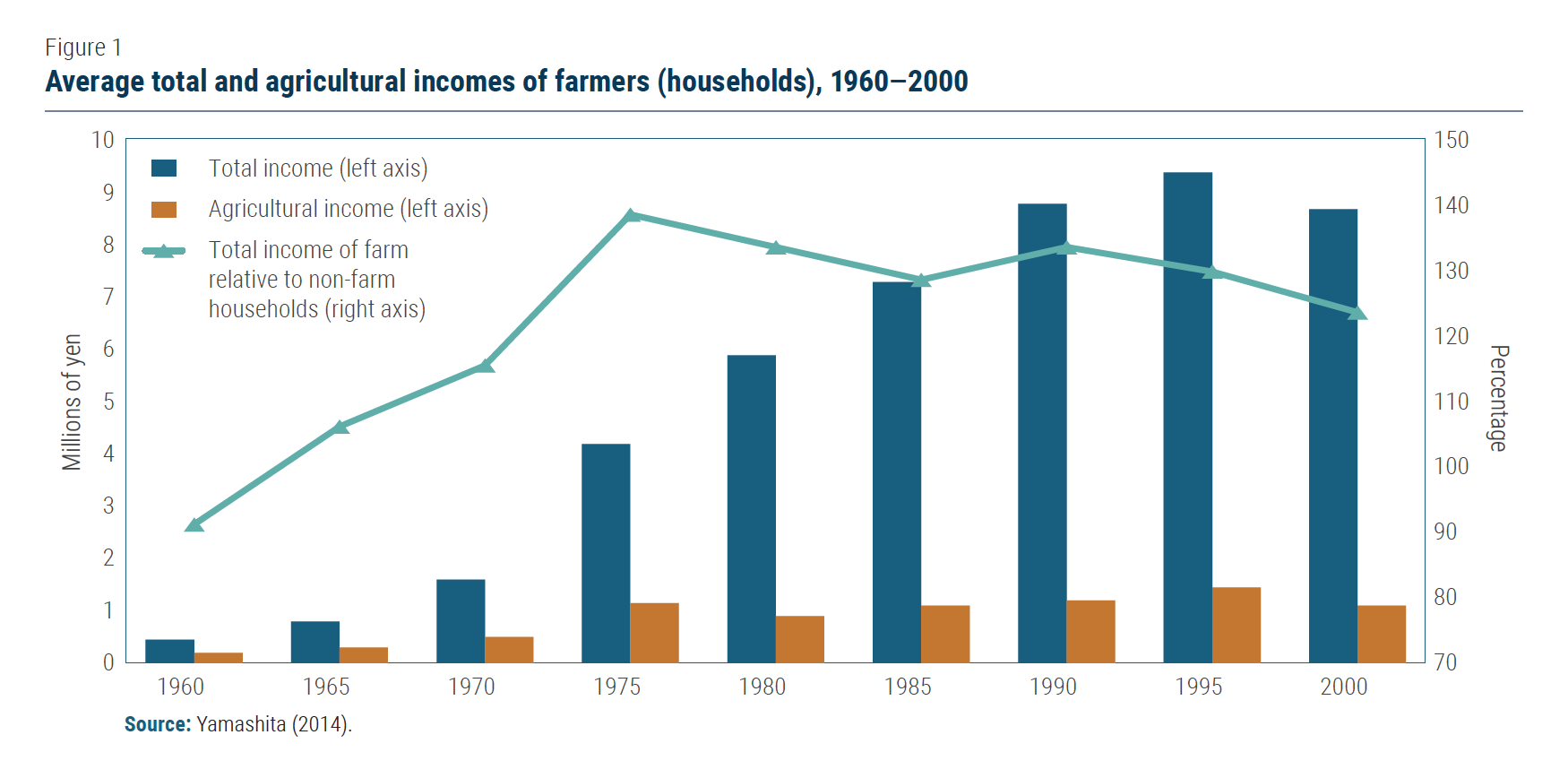 The series of land reform measures introduced since 1946 converted landless peasants to landowners. Farmers, now landowners, invested in land by applying fertilizers, introducing agricultural equipment and improving irrigation. The Government, alongside agricultural cooperatives established in 1948, played the pivotal role in improving well-being of rural residents, establishing the entire agricultural chain: land improvement, purchases and distribution of seeds and fertilizers, production, markets, distribution of outputs and financing. One important measure was the rice price subsidies that the Government provided to the farmers. The producer price was set to be 3 to 4 times higher than the international price. As a result, agricultural productivity increased. The typical farmer with 1 hectare of paddy rice field spent 251 days a year on the land in 1951, but worked only 30 days a year on the same land in 2000, with much less backbreaking work thanks to the mechanization of farming. With the decline in labour required for agriculture, farm households (nouka in Japanese) could take on non-farm activities. Younger members of farm households found jobs in their neighbouring areas, as the manufacturing and service sectors expanded in the countryside. The majority of farm households in Japan became part-time farmers whose main source of income were from non-farm activity (figure 1). The average farm household earned about $80,000 a year, 23 per cent higher than that of the average non-farm household in 2000. Higher productivity was achieved not only by improved technologies and farmland management but also by a holistic approach. Farmers had access to universal healthcare and free education. With better health status and education, they could understand, apply and improve the new technologies and land management they had learned. Better transport networks between rural and urban areas have made distributions of agricultural products more efficient and allowed some members of farm households to commute between their homes located in rural areas and workplaces located in urban areas. General knowledge and skills that the members of farm households received in school also made them adaptable to tasks outside agriculture. Table 1 shows basic health and education indicators by prefecture in Japan in the mid-2010s. Both education and health output indicators—average scores of the national test and life expectancies—show only marginal differences between prefectures with higher- and lower-density of population.
The series of land reform measures introduced since 1946 converted landless peasants to landowners. Farmers, now landowners, invested in land by applying fertilizers, introducing agricultural equipment and improving irrigation. The Government, alongside agricultural cooperatives established in 1948, played the pivotal role in improving well-being of rural residents, establishing the entire agricultural chain: land improvement, purchases and distribution of seeds and fertilizers, production, markets, distribution of outputs and financing. One important measure was the rice price subsidies that the Government provided to the farmers. The producer price was set to be 3 to 4 times higher than the international price. As a result, agricultural productivity increased. The typical farmer with 1 hectare of paddy rice field spent 251 days a year on the land in 1951, but worked only 30 days a year on the same land in 2000, with much less backbreaking work thanks to the mechanization of farming. With the decline in labour required for agriculture, farm households (nouka in Japanese) could take on non-farm activities. Younger members of farm households found jobs in their neighbouring areas, as the manufacturing and service sectors expanded in the countryside. The majority of farm households in Japan became part-time farmers whose main source of income were from non-farm activity (figure 1). The average farm household earned about $80,000 a year, 23 per cent higher than that of the average non-farm household in 2000. Higher productivity was achieved not only by improved technologies and farmland management but also by a holistic approach. Farmers had access to universal healthcare and free education. With better health status and education, they could understand, apply and improve the new technologies and land management they had learned. Better transport networks between rural and urban areas have made distributions of agricultural products more efficient and allowed some members of farm households to commute between their homes located in rural areas and workplaces located in urban areas. General knowledge and skills that the members of farm households received in school also made them adaptable to tasks outside agriculture. Table 1 shows basic health and education indicators by prefecture in Japan in the mid-2010s. Both education and health output indicators—average scores of the national test and life expectancies—show only marginal differences between prefectures with higher- and lower-density of population.  On the other hand, the prefectures with lower density of population enjoy higher levels of education and health inputs—numbers of schools per population and hospital beds. In recent years, some areas are facing challenges to maintain basic socioeconomic activities; shrinking populations, the declining incomes from agricultural activities and the increasing fiscal deficits both at the national and local levels, all make it difficult to keep towns or villages as independent administrative units. Despite these challenges, Japan has maintained the geographically balanced development across the country at the prefectural level. It should be noted that, even with higher agricultural productivity, the average farmers in Japan owns about 1 hectare of rice paddy field and, without non-farm activities, would not make the relative poverty line of ¥2.4 million ($22,900) for a family of 4 in Japan in 2015 (set at the 50% of the median disposable income). Based on the average productivity of paddy field (6 tonne/ha) and average whole price of rice, the average farmer would produce between ¥1.2 and ¥1.6 million ($11,400–$15,200) worth of rice per year. These simple calculations suggest the importance of non-farm income for farmers to enjoy a better quality of life, particularly when the average size of landholding by farmers is small.
On the other hand, the prefectures with lower density of population enjoy higher levels of education and health inputs—numbers of schools per population and hospital beds. In recent years, some areas are facing challenges to maintain basic socioeconomic activities; shrinking populations, the declining incomes from agricultural activities and the increasing fiscal deficits both at the national and local levels, all make it difficult to keep towns or villages as independent administrative units. Despite these challenges, Japan has maintained the geographically balanced development across the country at the prefectural level. It should be noted that, even with higher agricultural productivity, the average farmers in Japan owns about 1 hectare of rice paddy field and, without non-farm activities, would not make the relative poverty line of ¥2.4 million ($22,900) for a family of 4 in Japan in 2015 (set at the 50% of the median disposable income). Based on the average productivity of paddy field (6 tonne/ha) and average whole price of rice, the average farmer would produce between ¥1.2 and ¥1.6 million ($11,400–$15,200) worth of rice per year. These simple calculations suggest the importance of non-farm income for farmers to enjoy a better quality of life, particularly when the average size of landholding by farmers is small.
Government-led in situ urbanization of rural China
In situ urbanization in China has contributed to the development of some 20,000 small towns since the late 1970s and provided more than 100 million people with employment in the non-agricultural sectors. It has continued to contribute to the significant reduction in poverty and rural-urban migration in the country. In situ urbanization has been particularly prominent in the south-eastern coastal region of China. The process has involved the creation of new city centres, with the reclassification of areas from rural to urban, along with physical changes of rural settlements and infrastructure through the development of township and village enterprises (TVEs) (Zhu, 2017). Table 2 shows that the reclassification of rural areas to urban constituted about 67 per cent of the total urban population growth between 1982 and 1990 and the dominant role of in situ urbanization in population growth continued during the 1990s. Only in the 2000s did the rural-urban migration become the dominant factor in explaining the rapid increase of people living in urban areas. In 1978, TVEs employed about 28.3 million people, but the number increased to 130.5 million by 1997. By the end of the 20th century, the total value of TVEs’ output accounted for about 30 per cent of China’s GDP and its contribution to exports was about one third. The expansion of TVEs has created industrial parks and development zones, contributing to higher population density due to better infrastructure and public facilities. It has been the major driver of in situ urbanization by bringing structural and infrastructural changes to the rural areas. There are three factors that have particularly contributed to the emergence and development of in situ urbanization in China (Zhu et al., 2013):
a. Population density and infrastructure: In the late 1970s, population density in the coastal region reached 400 persons per km2, the common criterion for the definition as an urban territory. Relatively inexpensive means of transport, such as motorcycles, buses and trucks were available, with the rapidly improving and expanding road networks (Rodrigue, 2020). Inground and, later, wireless communication systems were also fast becoming available in many parts of the region. All these developments have reduced the necessity for rural dwellers to live near cities.
b. Internal and external socioeconomic conditions: Prior to the economic reforms of the 1970s, people in the coastal region invested in housing and created family- based workshops jointly owned by several households often financed by remittances received from overseas. With the commercial networks of overseas Chinese, people engaged in labour-intensive production, which required limited upfront capital and unskilled workforce. These family workshops were the fore-runners of TVEs, the incubators for in situ urbanization in the coastal region that emerged later. In October 1986, the Government enacted a new measure that welcomed foreign investment, leading to a larger inflow of capital into the region from overseas Chinese.
c. Policies and institutions: China’s household registration system, known as hukou—restricting rural-urban migration—as well as the national urban development strategy—limiting the growth of large and medium-sized cities—indirectly promoted in situ urbanization of the rural areas. The land tenure and social security systems in China also created disincentives for rural residents to move to urban centres and thus indirectly encouraged in situ urbanization. In addition, greater decentralized decision-making for economic development in the 1980s empowered local governments to create TVEs and urban centres in the rural areas.
Towards the end of the 1990s, a consensus emerged that large cities needed to accelerate their urbanization by better coordinating with surrounding smaller cities and towns. The removal of hurdles to rural-urban migration restricted by the hukou system also encouraged local governments to expand regional urban centres, particularly provincial capitals. As a result, the rural-urban migration has become more pronounced. But the more recent developments do not imply less relevance of in situ urbanization in the coastal provinces of China. In situ rural-urban transformation is ongoing, and the relatively dispersed spatial pattern of city locations will continue to affect the future models of urbanization at the provincial level.
In situ urbanization in Sri Lanka: rural first principle
Sri Lanka joined the group of upper-middle-income countries in 2019 without experiencing significant rural-urban migration. The country has achieved spatial equity between rural and urban areas in the provision of basic public services and living standards (World Bank, 2015). The urban population share in Sri Lanka increased from 15.3 per cent in 1950 to 18.7 per cent in 2020, while in South Asia as a whole, the same percentages increased from 16 to 37 per cent (UN DESA, 2018). Regional differences in Sri Lanka are minimal except in the Western Province, the location of the capital city, which exhibits stronger urban characteristics such as higher per-capita income, greater share of non-agricultural activities, and lower number of schools and hospitals per capita (table 3). Rural areas in Sri Lanka enjoy many social benefits and relatively high quality of life, in addition to rising percapita income over time. Although different political parties have ruled the country since the post-colonial period, they have consistently emphasized the development of rural societies—the “rural first principle”—guaranteeing universal free education and healthcare and offering affordable public transportation. The rural first principle does not mean agriculture first. The principle has been kept with higher shares of non-agricultural output across the country. 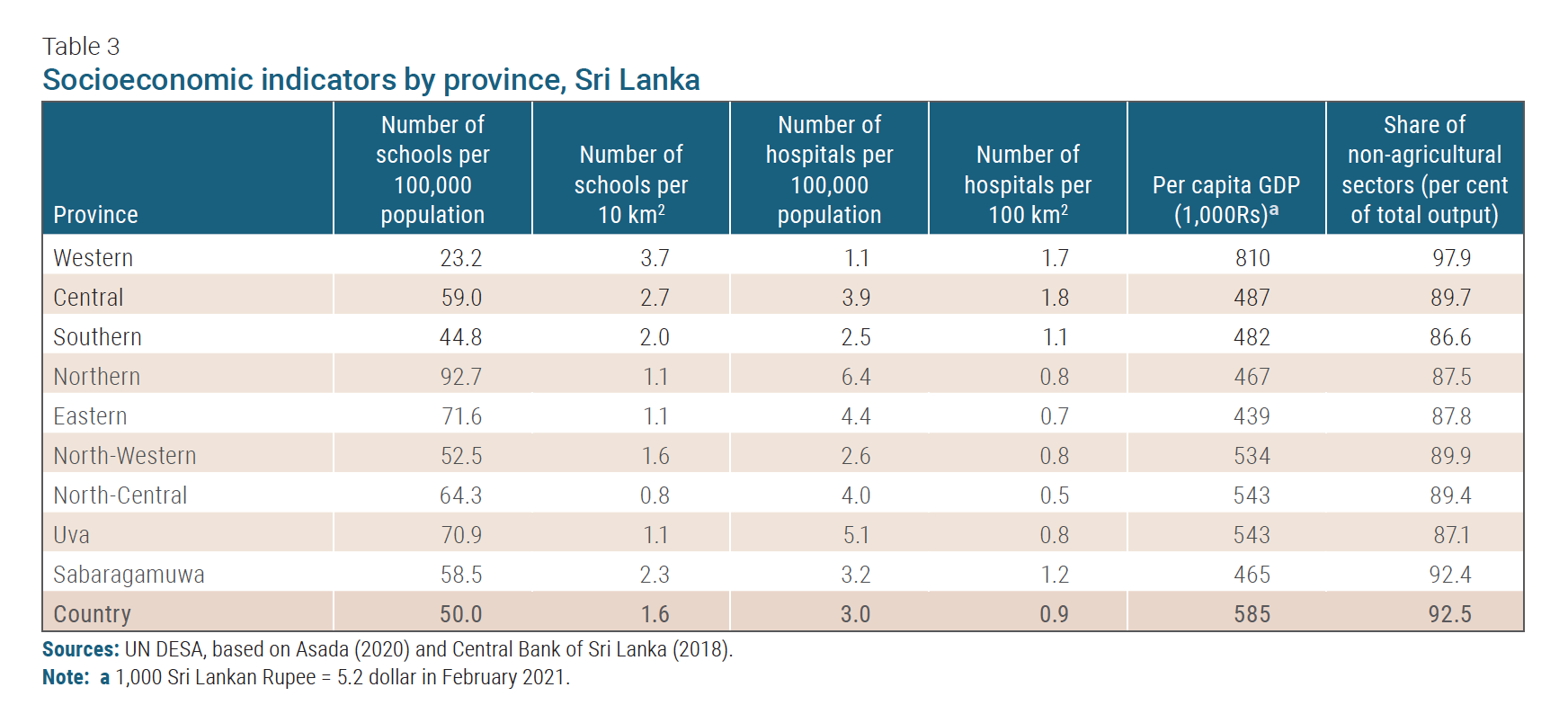 Asada (2020) argues that the rural first principle is rooted in the prosperity of the country during the pre-colonial period, when rice was the main economic activity, and the Buddhist culture emphasized a sustainable relation between humans and nature and between production and consumption. Schools and hospitals are located equally among provinces and districts although there are some disparities in terms of quality of service and facilities. Access to educational and medical facilities is enabled by reliable, subsidized public transport networks. Sri Lanka currently enjoys the highest level of health status and educational attainment, and the lowest poverty rate among South Asian countries. All these have reduced the need for rural residents to migrate to the cities. Public transport in the country has also played a key role in achieving a geographically balanced growth. The nation-wide bus network is expansive, and fares are kept low, which has facilitated rural-urban mobility. The currently changing economic conditions, however, are making it challenging for the country to maintain some of the social programmes based on the rural first principle. Its economy has stagnated in recent years and is heavily dependent on remittances from overseas, amounting to about 10 per cent of GDP. The Metro Colombo Urban Development Project, started in 2012, may contribute to further urbanization of the capital city in the long run and shift the rural-urban balance more to the latter. The Sri Lankan experience offers several lessons for other developing countries that are facing urbanization or rural development challenges. Maintaining universal welfare programmes is a key to achieving balanced rural-urban development as the provision of universal free education and healthcare has been a bedrock principle of the Sri Lanka development experience. The country’s expansive road networks and affordable public transport have also been critical in ensuring the access of all to schools and health facilities, and commutes between rural and urban areas, regardless of where they live. The country’s impressive progress in achieving spatial equity between rural and urban areas has thus reduced the incentives for rural residents to migrate to the cities.
Asada (2020) argues that the rural first principle is rooted in the prosperity of the country during the pre-colonial period, when rice was the main economic activity, and the Buddhist culture emphasized a sustainable relation between humans and nature and between production and consumption. Schools and hospitals are located equally among provinces and districts although there are some disparities in terms of quality of service and facilities. Access to educational and medical facilities is enabled by reliable, subsidized public transport networks. Sri Lanka currently enjoys the highest level of health status and educational attainment, and the lowest poverty rate among South Asian countries. All these have reduced the need for rural residents to migrate to the cities. Public transport in the country has also played a key role in achieving a geographically balanced growth. The nation-wide bus network is expansive, and fares are kept low, which has facilitated rural-urban mobility. The currently changing economic conditions, however, are making it challenging for the country to maintain some of the social programmes based on the rural first principle. Its economy has stagnated in recent years and is heavily dependent on remittances from overseas, amounting to about 10 per cent of GDP. The Metro Colombo Urban Development Project, started in 2012, may contribute to further urbanization of the capital city in the long run and shift the rural-urban balance more to the latter. The Sri Lankan experience offers several lessons for other developing countries that are facing urbanization or rural development challenges. Maintaining universal welfare programmes is a key to achieving balanced rural-urban development as the provision of universal free education and healthcare has been a bedrock principle of the Sri Lanka development experience. The country’s expansive road networks and affordable public transport have also been critical in ensuring the access of all to schools and health facilities, and commutes between rural and urban areas, regardless of where they live. The country’s impressive progress in achieving spatial equity between rural and urban areas has thus reduced the incentives for rural residents to migrate to the cities.
Conclusion
This Briefing has shown the importance of engaging with the rural non-farm economy for leaving no one behind. In situ urbanization of rural areas offers an alternative way of narrowing socioeconomic gaps between rural and urban areas, without invoking significant rural-urban migration. The Brief has demonstrated how income and welfare of rural people can be improved by establishing socioeconomic infrastructure and non-farm economic activities in rural areas, and how more geographically balanced growth can be achieved. In China, local and central governments played key and leading roles in planning and implementing in situ urbanization of rural areas with high population density. The Government of Sri Lanka used history-based rural first principle to guide rural development and to achieve a more geographically-balanced growth at the country level. The experience in Japan can be positioned between China and Sri Lanka. The Japanese Government planted seeds for rural development through land reform, but the structural transformation of the national economy later led the urbanization of the rural area. One common feature among these three countries, however the paths they have taken differ, is that urbanization of rural areas has been achieved by a holistic approach with universal healthcare, free or near-free education and improved infrastructure. Without this approach, the expansion of non-farm activities in rural areas could be limited to low value-added activities and be small scale at best. Experiences from in situ urbanization can be valuable ingredients of policy priorities for leaving no one behind.
 Welcome to the United Nations
Welcome to the United Nations
